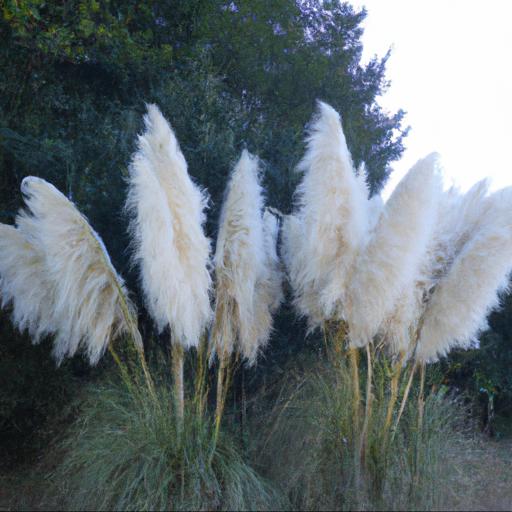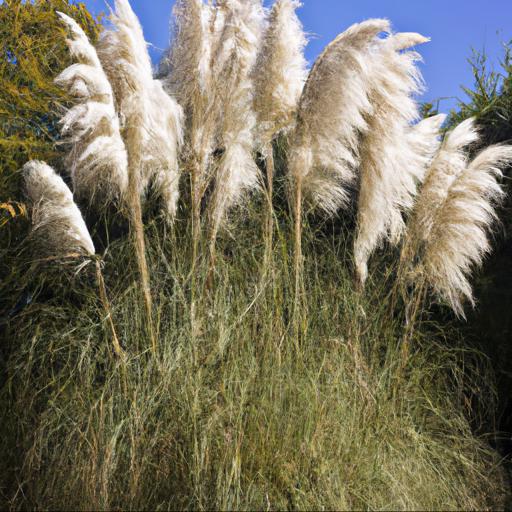Cortaderia selloana, commonly known as Pampas Grass, is a species of flowering plant native to South America. It is a tall, clump-forming grass with showy white or pink plumes, making it a popular ornamental in gardens and landscapes.
Pampas Grass is also a great choice for erosion control and windbreaks, and is often used as a backdrop for other plants. Its dense foliage and deep roots make it an excellent choice for naturalizing in a variety of settings. In this blog, we’ll discuss the many benefits of growing Cortaderia selloana and provide tips on how to care for it.
Benefits of growing cortaderia selloana

Gardening experts agree that Cortaderia selloana, commonly known as the pampas grass, is a great asset for any garden. Its swaying tassels of white, pink and silvery plumes add drama and movement to any garden, and its low maintenance requirement makes it perfect for busy gardeners. Whether you live in a city apartment or a country estate, Cortaderia has many benefits that make it a great addition to your garden.
For starters, the pampas grass’s height and broad foliage can create an attractive privacy screen, making it an ideal choice for city livers or those on the edge of a busy or noisy street. Its dense foliage can also act as a windbreaker in winter or provide a shaded area on hot summer days.
Award-winning garden designer Jane Alexander says Cortaderia’s “broad foliage creates a impressive back drop for other plants and draws the eye to the garden. ”Cortaderia is also highly resilient and easy to care for.
It’s able to tolerate a range of soils, including those with a higher clay content, and is drought tolerant. The plant can also handle tough winters, and its foliage will even give it a decorative winter effect. The only warning is to make sure you mow the grass every summer to prevent it from going to seed, as these plants can quickly take over an area!
Finally, Cortaderia is an evergreen grass that provides a year-round beauty that’s rarely found in a single plant. Its tall arching foliaged adds texture and a majestic silhouette to any garden, providing you with a timeless focal point and adding structure and interest no matter the season. As Jane Alexander says of this stunning plant, “It will bring instant structure, texture and colour to any garden.
”
Tips for planting and caring for cortaderia selloana

. Planting and Caring for Cortaderia SelloanaGardeners looking to add a stunning expanse of feathery foliage, beautiful blooms and a unique presence to their outdoor space will often find Cortaderia Selloana just right for their needs.
This majestic ornamental grasses may look imposing and delicate, but with the right knowledge and care, it can offer a spectacular display. Start by selecting a spot in your garden with full sun exposure and good air circulation for your Cortaderia Selloana. This ornamental grass grows best in soil with good drainage and high fertility.
Once you’ve planted your grass, give it a thorough soaking twice a week during the growing season. In periods of drought, aim for a regular soaking as often as needed to keep the grass green and healthy. When it’s time to prune your Cortaderia Selloana, you should use a sharp garden tool such as hedge shears or a pruning saw.
First, prune off any dead or damaged foliage and any intrusive flowering stalks. For a tidy look, shear off any excess growth at least twice a year.
Additionally, if you plan to harvest any seed heads, bear in mind that these may take several months to ripen. Therefore, well before harvesting, mark out the seed heads you plan to collect and cut away any unwanted stalks to avoid disappointment.
Throughout its life, your Cortaderia Selloana will likely require additional fertiliser to keep it in optimum condition. Firstly, check that it’s getting all the nourishment it needs by digging in a mix of compost and slow-release fertiliser directly into the soil. Additionally, during the spring and summer, it’s a good idea to feed the grass with a liquid fertiliser containing a balance of macronutrients.
By following these tips for planting and caring for Cortaderia Selloana, you will be able to enjoy the majestic beauty of this ornamental grass for many years to come. With the right environment and a caring touch, you can craft a beautiful and elegant display in your garden that will provide a tide of colour and fragrance throughout the seasons.
Common problems with cortaderia selloana

When it comes to Cortaderia selloana, commonly known as the pampas grass, this ornamental grass is often a source of trouble for many a UK gardener. While their spreading feathery blades are an impressive sight in the right conditions, their long taproots can cause considerable difficulty.
The pampas grass is a hardy and fast growing species, though getting it to thrive in an English climate can be tricky. Its strong root system is ideal for conservation, forming an effective erosion control on slopes, however in garden beds these long taproots can encroach onto other plants, choking them of the space they need to thrive. Keeping your pampas grass from becoming too invasive will take regular maintenance, especially if it has been established for some time.
Another common problem with this species is that it can be highly flammable, meaning it is a huge fire risk. This can be mitigated with a good trimming routine, removing any stray dried blades from the centre of the plant.
It may also be a good idea to plant your pampas grass away from any major structures or large trees that might catch fire. Keep an eye out for any excessive growth and make sure to trim any tall plumes with caution. In conclusion, Cortaderia selloana, or pampas grass, can be a wonderful addition to any UK garden.
With regular maintenance, including a trim down on any dead foliage, this ornamental grass poses few issues. Consider the unique needs of this species when planning its placement in your outdoor space and be mindful of its fire risk and taproot habit.
With a little extra attention, your pampas grass should bring great beauty to your backyard.
Conclusion
Cortaderia selloana, commonly known as pampas grass, is a species of flowering plant native to South America. It is known for its tall, feathery plumes and can be used as a decorative element in gardens and landscaping. It is also a popular choice for windbreaks and privacy screens.
Pampas grass is hardy and low maintenance, making it an ideal choice for gardeners of all levels.
FAQ
What is the scientific name of Cortaderia selloana?
The scientific name of Cortaderia selloana is Cortaderia selloana (Schult. & Schult.f.) Asch. & Graebn.
What are the common uses of Cortaderia selloana?
The common uses of Cortaderia selloana include ornamental landscaping, erosion control, and as a windbreak.
What is the native range of Cortaderia selloana?
Cortaderia selloana is native to South America, primarily in Argentina, Chile, and Uruguay.
How does Cortaderia selloana reproduce?
Cortaderia selloana reproduces primarily through vegetative propagation, such as rhizomes and tillers, but can also reproduce sexually by producing seeds.
What are the potential problems associated with Cortaderia selloana?
The potential problems associated with Cortaderia selloana are its invasiveness, its ability to spread quickly, and its potential to outcompete native species. It can also cause problems with water drainage and soil erosion.
How can Cortaderia selloana be managed?
Cortaderia selloana can be managed by controlling its spread by removing seed heads before they disperse, planting it in areas where it can be contained, and using herbicides to control its spread.

